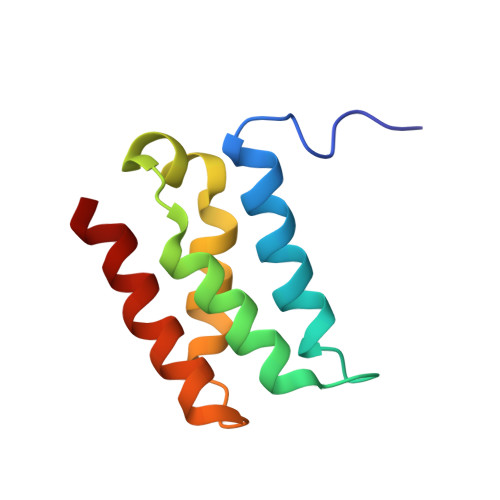Validation and Structural Characterization of the LEDGF/p75-MLL Interface as a New Target for the Treatment of MLL-Dependent Leukemia.
Cermakova, K., Tesina, P., Demeulemeester, J., El Ashkar, S., Mereau, H., Schwaller, J., Rezacova, P., Veverka, V., De Rijck, J.(2014) Cancer Res 74: 5139-5151
- PubMed: 25082813
- DOI: https://doi.org/10.1158/0008-5472.CAN-13-3602
- Primary Citation of Related Structures:
2MSR - PubMed Abstract:
Mixed lineage leukemia (MLL) fusion-driven acute leukemias represent a genetically distinct subset of leukemias with poor prognosis. MLL forms a ternary complex with the lens epithelium-derived growth factor (LEDGF/p75) and MENIN. LEDGF/p75, a chromatin reader recognizing H3K36me3 marks, contributes to the association of the MLL multiprotein complex to chromatin. Formation of this complex is critical for the development of MLL leukemia. Available X-ray data represent only a partial structure of the LEDGF/p75-MLL-MENIN complex. Using nuclear magnetic resonance spectroscopy, we identified an additional LEDGF/p75-MLL interface, which overlaps with the binding site of known LEDGF/p75 interactors-HIV-1 integrase, PogZ, and JPO2. Binding of these proteins or MLL to LEDGF/p75 is mutually exclusive. The resolved structure, as well as mutational analysis, shows that the interaction is primarily sustained via two aromatic residues of MLL (F148 and F151). Colony-forming assays in MLL-AF9(+) leukemic cells expressing MLL interaction-defective LEDGF/p75 mutants revealed that this interaction is essential for transformation. Finally, we show that the clonogenic growth of primary murine MLL-AF9-expressing leukemic blasts is selectively impaired upon overexpression of a LEDGF/p75-binding cyclic peptide CP65, originally developed to inhibit the LEDGF/p75-HIV-1 integrase interaction. The newly defined protein-protein interface therefore represents a new target for the development of therapeutics against LEDGF/p75-dependent MLL fusion-driven leukemic disorders. Cancer Res; 74(18); 5139-51. ©2014 AACR.
Organizational Affiliation:
KU Leuven, Laboratory for Molecular Virology and Gene Therapy, Department of Pharmaceutical and Pharmacological Sciences, Leuven, Belgium.















